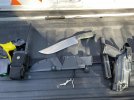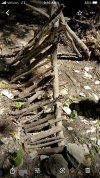- Joined
- Jul 11, 2020
- Messages
- 509
The BladeForums.com 2024 Traditional Knife is available! Price is $250 ea (shipped within CONUS).
Order here: https://www.bladeforums.com/help/2024-traditional/
If you carry that much stuff for a day hike... you will not be able to enjoying it much. I don't want to imagine what you will be carrying for an overnight then!Even on day hikes I nowadays try to carry enough to survive an unplanned overnight reasonably comfortably (tent, foam pad, extra clothing/ light sleeping bag, chair etc) in case I injure myself and can’t walk out. Poles, Inreach, Gaia app on phone, headlamp, saw etc
Right, when I’m climbing I leave all that stuff (tent, sleeping bag etc) behind to save weight. If I’m just hiking (or backpacking), I can afford to carry the tent (2 lb 5 oz), chair (1 lb) and other stuff, total (including pack) maybe 14 lbs before water. Perhaps the woman who died in the White mountains would have survived if she had been carrying more.If you carry that much stuff for a day hike... you will not be able to enjoying it much. I don't want to imagine what you will be carrying for an overnight then!
There is a fine line (and it is not the same for everyone) between carrying too much crap that weights a ton and prevents you from moving fast... and carrying so little that if you need to spend the night out it is going to become a disaster.
I always carry a space blanket (that could be upgraded to a space bag, which is the same thing but in a sleeping bag shape), hat, gloves and a puffy jacket (either down of synthetic of different weights/warmths depending on the circumstances). Apart from the regular clothing I intend to use I mean.
In the mountains, speed is safety... I learn't that the hard way in the Alps... Usually people "think" they are going light and carrying only the essentials untill they go climbing in the Mont Blanc range and realise how little the mountain guides and proficient people carry in a daily basis... The more you go out, the less you carry, no doubt.
Mikel
If you carry that much stuff for a day hike... you will not be able to enjoying it much. I don't want to imagine what you will be carrying for an overnight then!
There is a fine line (and it is not the same for everyone) between carrying too much crap that weights a ton and prevents you from moving fast... and carrying so little that if you need to spend the night out it is going to become a disaster.
I always carry a space blanket (that could be upgraded to a space bag, which is the same thing but in a sleeping bag shape), hat, gloves and a puffy jacket (either down of synthetic of different weights/warmths depending on the circumstances). Apart from the regular clothing I intend to use I mean.
In the mountains, speed is safety... I learn't that the hard way in the Alps... Usually people "think" they are going light and carrying only the essentials untill they go climbing in the Mont Blanc range and realise how little the mountain guides and proficient people carry in a daily basis... The more you go out, the less you carry, no doubt.
Mikel
During coldest winter I wear shemagh or wool square scarf near my mouth so that the warm fumes from my mouth warm the face. It’s very comfy when the weather starts to go below -20celcius.I used a reflective blanket once when camping inside a cave (temperature around 50 degrees F, 100% humidity) and did not feel that it helped me stay warm at all (I also had a light sleeping bag and foam pad.) Which is why I now carry a very puffy down vest, down hood, chair, poncho to cover all the above etc. A dry extra base layer to change into also makes a big difference I think. And some cashews or similar high calorie snack (I once had to stand around for several hours in the cold and found that popping a couple cashews whenever I started to get chilly helped.). Ps. One unexpected learning during this pandemic is that I lose a lot of heat from normal exhalation through my mouth, so that wearing a close fitting N95 mask over my mouth and nose makes me warmer.

Beginnings of a debris shelterSome sketchy stories above - I’m glad everyone made it back with all their fingers and toes!
Part of my job entails searching for lost hikers.
In about 18 years I’ve been out looking dozens of times, and in all that time only ONE person had a map and a compass, (although of course he was off trail so he ended up at the edge of a cliff he couldn’t climb down). ZERO people have had adequate gear to keep them comfortable through a night.
Preparation or lack of it can cascade in a positive or negative direction very quickly, and I think the large majority of people that only intend to go on a “hike” are underprepared for an unexpected night in the woods.
I EDC a knife, mini ferro rod, and some duct tape just around town.
If I’m heading out for a solo hike, or searching for a hiker, the minimum I’m comfortable with (in a mild climate) is to add a larger chopping knife and/or saw to the small knife, ferro rod and duct tape. Now I have both fire and the ability to gather more wood and make a debris shelter much more efficiently than with just a pocket knife.
A large debris shelter (with a heavy emphasis on a very thick vegetation “mattress” is the most important skill/knowledge to have in the woods imho, and is the first thing I’ll start making in a survival situation.

I love the Silky F-180 for hiking - it’s the lightest and least expensive model. There’s not much metal in the handle so it’s presumably less durable than their other models, but perfect for the survival saw role (again in a mild climate - I’d take something bigger and some kind of waterproof membrane at least if it was colder…)ordeal has me thinking about adding a Silky for my bare essentials. They weigh almost nothing, but man can they fuel a fire!
One environmental consideration is whether there are trees around to tie a tarp to or to provide material for shelter construction, or whether the ground is soft enough to accept stakes, or whether the shelter needs to be self standing.On the topic of shelters/debris mattresses, it shows why its key to plan your strategy around your location/environment. In my case, I'm more likely to be stuck somewhere due to an unexpected major rainstorm, so i'd better have a tarp or other easy shelter, or snakebite, which means no movement, and so any shelter has to be reasonably effective with very little effort. When I walked in the Rockies, different conditions, and in general a different set of needs/concerns. For example, I thought I knew cold living in the prairies, but until I lived down here I'd never experienced 5C at 100% humidity, and that is a different beast. So there really is no one rule set. I'll say that while I agree that a map and compass are a good thing, if it's your only survival tool, it leaves a lot of possibilities unaccounted for.

If you like to read, you should check out My First Summer In The Sierra, by John Muir, the founder of the Sierra Club. Great story(ies) and inspirational at points.My first backpacking trip was when I was 11, in the Adirondacks in New York. For the last 21 years I have done a lot of backpacking in the Sierra (see my most recent trip in the thread about going to Mt Whitney with some youth).
Two of my sons have gone with me. One is not terribly interested in doing more, while the other still likes it.
I was out for a few days in the backcountry on a little used trail headed to a popular campground. The trail was massivley over grown and required some bushwhacking and bouldering. My son and I kept leapfrogging a group of boy scouts throughout the day. We had finished eating our lunch and had come up behind them. It was pouring rain and the group of about 12 was spread out along the trail while the adults were talking. One of their scouts had gone way off ahead and they were very concerned that their GPS was telling them they needed to be "about a quarter mile over there." They asked me what I was using for navigation. I told them that I trusted the blazes on the trail far more than an electronic device. I took out my topographic map and showed them where we were based on the landmarks we had passed. I showed them all the major rivers and intersections we had passed since leaving the same camp earlier that morning. My son and I continued on an they were pretty confident to follow us. My son and I caught up to their lone scout about 45 min later. He was sitting on the opposite side of a river crossing and asked us if he had seen his troop. It was pretty hairy in my opinion. I was relieved when they all made it into camp. People have too much blind faith in technology.Some sketchy stories above - I’m glad everyone made it back with all their fingers and toes!
Part of my job entails searching for lost hikers.
In about 18 years I’ve been out looking dozens of times, and in all that time only ONE person had a map and a compass, (although of course he was off trail so he ended up at the edge of a cliff he couldn’t climb down). ZERO people have had adequate gear to keep them comfortable through a night.
Preparation or lack of it can cascade in a positive or negative direction very quickly, and I think the large majority of people that only intend to go on a “hike” are underprepared for an unexpected night in the woods.
I EDC a knife, mini ferro rod, and some duct tape just around town.
If I’m heading out for a solo hike, or searching for a hiker, the minimum I’m comfortable with (in a mild climate) is to add a larger chopping knife and/or saw to the small knife, ferro rod and duct tape. Now I have both fire and the ability to gather more wood and make a debris shelter much more efficiently than with just a pocket knife.
Large debris shelter construction (with a heavy emphasis on a very thick vegetation “mattress”) is the most important skill/knowledge to have in the woods imho, and it’s the first thing I’ll start making in a survival situation.
View attachment 2009075
I was out for a few days in the backcountry on a little used trail headed to a popular campground. The trail was massivley over grown and required some bushwhacking and bouldering. My son and I kept leapfrogging a group of boy scouts throughout the day. We had finished eating our lunch and had come up behind them. It was pouring rain and the group of about 12 was spread out along the trail while the adults were talking. One of their scouts had gone way off ahead and they were very concerned that their GPS was telling them they needed to be "about a quarter mile over there." They asked me what I was using for navigation. I told them that I trusted the blazes on the trail far more than an electronic device. I took out my topographic map and showed them where we were based on the landmarks we had passed. I showed them all the major rivers and intersections we had passed since leaving the same camp earlier that morning. My son and I continued on an they were pretty confident to follow us. My son and I caught up to their lone scout about 45 min later. He was sitting on the opposite side of a river crossing and asked us if he had seen his troop. It was pretty hairy in my opinion. I was relieved when they all made it into camp. People have too much blind faith in technology.
You too?? The only time I eat McDonalds these days is after a backpacking trip. If you’re out for a few days the idea of a burger and shake starts to become a serious daydream.Nothing beats getting back in the car and hitting that fast food joint.
For sure!That is the story I usually tell people who place too much faith in electronic devices. I would rather trust a topo map and compass.
You too?? The only time I eat McDonalds these days is after a backpacking trip. If you’re out for a few days the idea of a burger and shake starts to become a serious daydream.
For sure!
Maybe you can carry freeze dried ice cream on your trips…After a week in the high country I don't crave fast food, I crave ice cream. I live at 300' above sea level, and when I spend time above 10,000' I have very little appetite, and have to choke food down. I typically run a significant calorie deficit, losing up to a pound per day. When I get back down to sea level, my body is craving calories, and ice cream just hits the spot.
